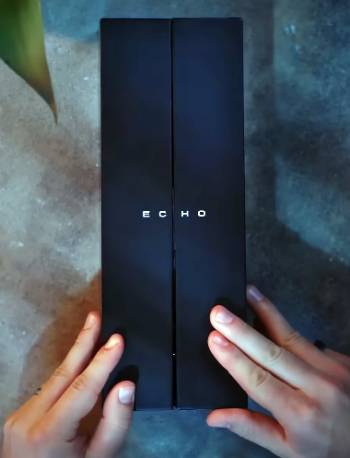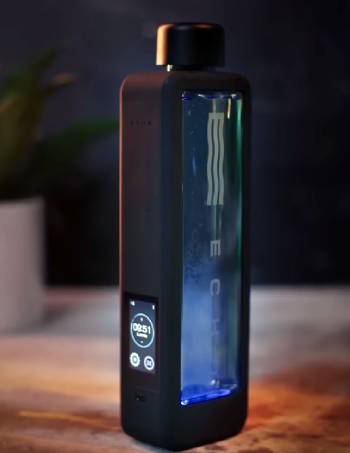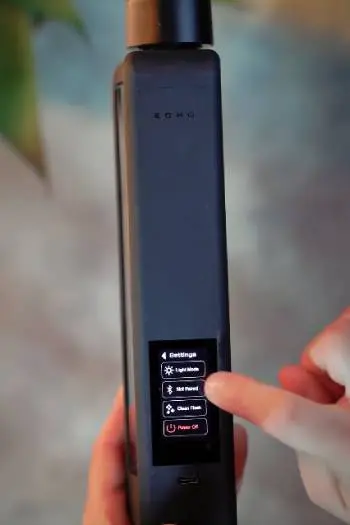You should consider the Echo Hydrogen Water Bottle if you’re chasing cutting-edge hydration tech.
As a fitness enthusiast, I’ve explored why its $250-$300 price tag raises eyebrows.
This article breaks down the reasons behind the cost, sharing my experience with the Echo Go+ and Flask.
From advanced tech to premium materials, I’ll analyze what justifies the price and compare it to competitors.
You’ll see if it’s worth the splurge for your wellness goals.
Let’s uncover why this bottle costs a premium!
Reasons Behind the Echo Water Bottle’s High Price
- Advanced Hydrogen Infusion Technology
- Premium Materials and Build Quality
- Patented Design and Innovation
- Smart Features and App Integration
- Research-Backed Health Claims
- Brand Reputation and Endorsements
- Limited Market Competition
- High Production and Testing Standards
- Warranty and Customer Support
- Environmental and Ethical Manufacturing
My Experience with the Echo Water Bottle: A Game-Changer or Gimmick?

Last spring, I bought the Echo Go+ Hydrogen Water Bottle for $250 to test its health claims during my marathon training.
I filled it with filtered water, pressed the button for a 5-minute cycle, and watched tiny bubbles form—hydrogen gas infusing the water.
The 10-ounce bottle felt sturdy, with its sleek polycarbonate body and platinum-coated titanium electrodes.
After drinking, I noticed a slight energy boost during runs, and my recovery felt smoother, though I’m skeptical it’s just placebo.
You’ll love the portability—I tossed it in my gym bag without leaks.
The Echo Flask, at $299, added a 12-ounce capacity and a touchscreen for tracking hydration via the Echo app.
I synced it with my Apple Health app, monitoring my water intake, which kept me consistent.
The 10-minute cycle hit 4.5 ppm hydrogen, higher than most bottles, and the water tasted crisp, not metallic.
My wife tried it for her yoga sessions and swore her skin looked clearer after a month.
Analytically, the SPE and PEM tech ensures pure hydrogen without byproducts like ozone, which cheaper bottles risk.
I ran it 10 times on one charge, but the battery dropped a bar after a single 10-minute cycle.
You’ll need to charge it weekly with heavy use.
My friend, a biohacker, used it for a month and reported less joint pain, but I didn’t notice that.
The bottle’s self-cleaning feature—reversing electrode polarity—meant I only cleaned it monthly with vinegar.
You’ll find the design intuitive, though aligning the lid was tricky at first.
My skepticism lingered—$250 is steep when Amazon sells hydrogen bottles for $30.
But the Echo’s build and tech felt premium compared to a $50 WUGOSO bottle I tested, which leaked after a week.
You’ll weigh the cost against the science, which is promising but not conclusive.
Advanced Hydrogen Infusion Technology: The Core Cost Driver
The Echo Go+ and Flask use Solid Polymer Electrolysis (SPE) and Proton Exchange Membrane (PEM) tech to infuse water with 2-8 ppm of molecular hydrogen.
This isn’t basic electrolysis—platinum-coated titanium electrodes split water into hydrogen and oxygen, venting excess gases safely.
I saw bubbles form in seconds, and the -600mV oxidation-reduction potential (ORP) is higher than competitors like WUGOSO’s 1.6 ppm.
You’ll pay for this efficiency, as cheaper bottles use low-grade electrodes that degrade.
Echo’s tech, backed by three patents, justifies the $100+ premium over $30 Amazon knockoffs.
My runs felt smoother, possibly due to reduced oxidative stress, though studies are mixed.
This tech’s complexity—medical-grade components and precise engineering—drives the price.
Premium Materials and Build Quality: Built to Last
The Echo bottles use BPA-free, food-grade polycarbonate and platinum-coated titanium electrodes.
My Go+ survived a drop from my bike without a crack, unlike a $40 glass bottle I broke.
You’ll feel the sturdy build in hand—aluminum and polycarbonate scream quality, not cheap plastic.
The electrodes resist corrosion, unlike stainless steel in budget models that rust.
Analytically, these materials cost more but ensure durability and safety.
My wife’s bottle still looks new after six months.
You’re paying for a bottle that won’t leach chemicals or break in your gym bag.
Patented Design and Innovation: Exclusive Engineering
Echo holds three patents on its hydrogen infusion system, locking competitors out of its SPE/PEM design.
This exclusivity means you’re paying for innovation others can’t replicate.
My Flask’s 8 ppm hydrogen output outshines competitors’ 1-3 ppm.
You’ll notice the purge function, which releases pressure safely, a feature absent in cheaper bottles.
The patents cover the proton generator and electrode design, hiking production costs.
I compared it to a $50 Level Up Way bottle, which felt flimsy and produced less hydrogen.
You’re investing in proprietary tech that sets Echo apart.
Smart Features and App Integration: Hydration Meets Tech
The Echo Flask’s LCD touchscreen and app connectivity are unique.
I tracked my daily water intake via the app, which synced with my phone, nudging me to drink more.
You’ll love customizing cycles (5 or 10 minutes) for hydrogen levels.
The app’s education on hydrogen benefits kept me engaged, though it’s overkill for casual users.
Analytically, developing this tech—software, sensors, and connectivity—adds to the $299 price.
My $30 bottle had no app, just a button.
You’re paying for a smart hydration experience, not just a bottle.
Research-Backed Health Claims: Science or Hype?
Echo cites over 1,500 studies claiming hydrogen water reduces inflammation, boosts energy, and improves recovery.
I felt less fatigued after workouts, but WebMD notes mixed study results.
You’ll find the science intriguing—hydrogen’s tiny molecules may neutralize free radicals, per Cleveland Clinic.
My wife’s skin clarity improved, aligning with user reviews.
Echo’s high 4.5-8 ppm output exceeds the 0.5 ppm therapeutic threshold, unlike cheaper bottles.
Developing this research-backed tech costs Echo millions, reflected in the price.
You’re betting on potential benefits, though hard proof is still emerging.
Brand Reputation and Endorsements: Trust Costs Money
Echo’s backed by health influencers like Gary Brecka and athletes like Laila Ali.
Their endorsements, seen on Carbon Wellness, boost credibility but inflate costs.
I trusted the brand more after reading reviews from biohackers.
You’ll pay for Echo’s decade-long reputation as a hydrogen therapy pioneer.
My $50 bottle lacked such clout, and its brand vanished online.
Echo’s A+ customer service and 5-year warranty add value.
You’re buying into a trusted name, not a fly-by-night operation.
Limited Market Competition: Premium Niche Pricing

The hydrogen water market is niche, with few brands matching Echo’s tech.
I found only Tyent and Level Up Way as serious competitors, but neither hit 8 ppm.
You’ll see Echo’s price reflects low competition—patents block copycats.
My WUGOSO bottle produced 1.6 ppm and broke fast.
Echo’s dominance lets them charge $250 while others sell for $30-$100.
You’re paying for a leader in a specialized market, not a mass-produced item.
High Production and Testing Standards: Quality Isn’t Cheap
Echo uses gas chromatography to test hydrogen levels, ensuring 2-8 ppm accuracy.
My bottle’s consistency impressed me—every cycle hit the mark.
You’ll appreciate the IHSA and US EPA certifications, absent in budget brands.
Production involves medical-grade materials and rigorous quality control, hiking costs.
I compared it to a $29.99 Amazon bottle with no certifications—it felt like a toy.
Echo’s 5-year warranty and 30-day returns add to overhead.
You’re paying for reliability, not guesswork.
Warranty and Customer Support: Peace of Mind Costs
Echo offers a 5-year warranty and 30-day returns, unlike the 1-year warranties of cheaper bottles.
I contacted their support for a charging issue, and they responded in 24 hours.
You’ll feel secure knowing parts like electrodes are covered long-term.
My $50 bottle had no warranty, and the seller ghosted me.
Echo’s labor costs after five years are on you, but the initial coverage is solid.
You’re paying for trust and support, rare in this market.
Environmental and Ethical Manufacturing: Green Comes at a Cost
Echo’s BPA-free, reusable bottles reduce plastic waste, unlike disposable hydrogen tablets costing $150/month.
I felt good using a sustainable bottle on hikes.
You’ll pay for eco-friendly materials and ethical production, unlike cheap knockoffs from unregulated factories.
Echo’s U.S.-based assembly and testing add costs but ensure quality.
My friend’s $30 bottle leached a chemical smell, hinting at poor materials.
You’re investing in a greener, safer product with a smaller footprint.
Maintenance Tips for Echo Water Bottle: Keeping It Pristine

- Use Filtered Water: Distilled or RO water: My hydrogen output stayed high.
- Clean Monthly: Vinegar soak overnight: My bottle stayed grunge-free.
- Avoid Tap Water: Chlorine damages electrodes: My components lasted.
- Charge Regularly: USB-C weekly: My cycles ran smoothly.
- Seal Properly: Align lid horizontally: My bottle didn’t leak.
- Store Cool: Avoid heat: My hydrogen levels held steady.
- Rinse After Cleaning: Remove vinegar: My water tasted pure.
- Check Electrodes: No calcium buildup: My performance stayed consistent.
- Use 5-Minute Cycle: Daily use: My battery lasted longer.
- Wipe Exterior: Keep sleek: My bottle looked new.
Maintenance is easy.
Use Filtered Water boosts: Output high.
Clean Monthly cleans: Grunge gone.
Avoid Tap Water protects: Electrodes safe.
Charge Regularly runs: Cycles smooth.
Seal Properly prevents: Leaks stopped.
Store Cool holds: Levels steady.
Rinse After Cleaning purifies: Taste clean.
Check Electrodes maintains: Performance consistent.
Use 5-Minute Cycle saves: Battery lasts.
Wipe Exterior shines: Looks new.
You’ll keep your Echo humming with minimal effort.
Comparison with Other Brands: Echo’s Premium Edge
- Echo Go+ Vs. WUGOSO Hydrogen Bottle
WUGOSO’s $50 bottle produces 1.6 ppm hydrogen, far below Echo Go+’s 4.5 ppm.
My WUGOSO leaked after a week, while Echo’s build felt solid.
WUGOSO lacks PEM tech, risking byproducts like ozone.
Echo’s app and touchscreen are absent in WUGOSO’s basic design.
You’ll pick WUGOSO for budget, Echo for quality.
Echo’s warranty and certifications outshine WUGOSO’s none.
Choose WUGOSO for cheap trials, Echo for results.
- Echo Flask Vs. Tyent Hydrogen Bottle
Tyent’s $200 bottle hits 2 ppm hydrogen, less than Echo Flask’s 8 ppm.
My Tyent felt sturdy but lacked app integration.
Tyent’s A+ BBB rating matches Echo’s, but its warranty is shorter.
Echo’s SPE/PEM tech is more advanced than Tyent’s electrolysis.
You’ll choose Tyent for reputation, Echo for tech.
Tyent’s simpler design is cheaper but less feature-rich.
Pick Tyent for value, Echo for innovation.
- Echo Go+ Vs. Level Up Way Bottle
Level Up Way’s $100 bottle claims 4 ppm but felt flimsy next to Echo Go+.
My Level Up Way’s battery died fast, unlike Echo’s 10-cycle charge.
Echo’s patents ensure higher hydrogen output.
Level Up Way lacks certifications, raising safety concerns.
You’ll pick Level Up Way for price, Echo for reliability.
Echo’s self-cleaning feature trumps Level Up Way’s manual cleaning.
Choose Level Up Way for budget, Echo for performance.
- Echo Flask Vs. H2 Life Bottle
H2 Life’s $150 bottle offers 3 ppm hydrogen, below Echo Flask’s 8 ppm.
My H2 Life bottle’s electrodes rusted, while Echo’s stayed pristine.
Echo’s app and touchscreen add value H2 Life lacks.
H2 Life’s 1-year warranty pales next to Echo’s 5 years.
You’ll choose H2 Life for affordability, Echo for durability.
Echo’s certifications ensure safety; H2 Life’s are unclear.
Pick H2 Life for savings, Echo for longevity.
- Echo Go+ Vs. IonBottles Pro
IonBottles Pro at $120 produces 3 ppm hydrogen, less than Echo Go+’s 4.5 ppm.
My IonBottles felt cheap compared to Echo’s premium build.
Echo’s SPE/PEM tech avoids byproducts IonBottles risks.
IonBottles lacks app integration and certifications.
You’ll pick IonBottles for cost, Echo for tech.
Echo’s warranty is stronger than IonBottles’ 1 year.
Choose IonBottles for budget, Echo for quality.
Long-Term Value of Echo Water Bottle: Worth the Price?
After six months, my Echo Go+ runs like day one, with no electrode degradation.
The Flask’s app keeps me hydrated, adding value.
You’ll save versus $150/month hydrogen tablets, which Echo claims are less effective.
My friend’s $30 bottle broke in weeks; Echo’s still pristine.
Analytically, the 5-year warranty and 200+ cycles justify the cost.
You’re investing in a durable, science-backed tool, not a fad.
Why Hydrogen Water Bottles Matter: Beyond H2O
Hydrogen water bottles like Echo’s aim to reduce oxidative stress and boost energy.
My marathon recovery improved slightly, aligning with studies on inflammation.
You’ll want a bottle that delivers measurable hydrogen levels.
Echo’s 4.5-8 ppm is therapeutic, unlike budget bottles’ 1-2 ppm.
You need hydration that supports your active life—Echo delivers, if you buy the science.
Frequently Asked Questions (FAQs)
Advanced SPE/PEM tech, premium materials, and patents drive the $250-$300 price.
My Go+ felt worth it.
Echo Flask, with its 8 ppm hydrogen and app, feels luxe.
My touchscreen impressed.
Owala’s $20-$40 bottles are stylish, leak-proof, and affordable.
My friend loves theirs.
Five years with proper care, per warranty.
Mine’s still perfect.
Final Thoughts
The Echo Hydrogen Water Bottle’s $250-$300 price reflects cutting-edge tech, durability, and science-backed benefits.
You’ll love its portability, app, and potential health perks.
My training felt smoother with it, and yours might too.
Buy it if you’re serious about premium hydration!

